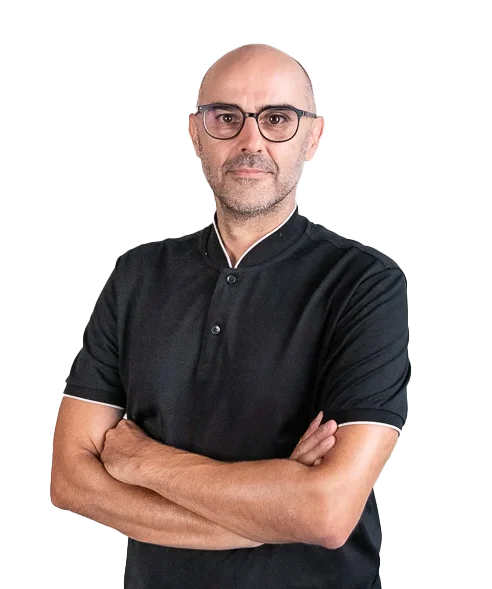LISTEN TO THE Event Speakers
Pr. Alberto J. Campillo Fernández
Universitat Politècnica de València, UPV

Pr. Alberto J. Campillo Fernández
Universitat Politècnica de València, UPV
Title: Development of a novel biodegradable device for the potential closure of postoperative fistulas
Authors: Marina García-Castellanos, Vicente Lorenzo-Zúñiga, Guillermo Vilariño- Feltrer, Isabel Tort-Ausina, Rubén Martín-Cabezuelo, Vicente Pons Beltrán, Alberto Campillo-Fernández.
Postoperative fistulas remain a frequent and challenging complication, particularly after gastrointestinal and colorectal surgeries, often leading to prolonged hospitalization, infection, and increased morbidity. Current closure techniques, including clips, sutures, and negative pressure therapies, present important limitations. To address these shortcomings, a novel biodegradable device has been developed, combining a 3D-printed anchoring structure with a molded globular component designed to seal the fistulous tract securely. The anchoring element ensures mechanical stability, while the globular component provides a flexible and adaptable seal, reducing risks of leakage or migration. The design and manufacturing process followed an iterative approach, integrating in vitro and ex vivo testing to optimize deployment, fixation, and sealing capacity. This integrated system aims to minimize the need for secondary procedures, improve patient safety, and reduce healthcare resources. By offering an innovative approach to fistula management, this work highlights the potential of combining advanced manufacturing techniques with functional design to achieve a clinically effective and sustainable solution.Pr. Jamal Taoufik
Ex Directeur du Médicament et de la Pharmacie Ministère de la santé.

Pr. Brahim El Ouadi
Université de la Rochelle, France & ENSAM-Université Mohammed 5 – Rabat, Maroc

Pr Asmaa Hatim
Faculté de médecine Dentaire – Université Mohammed VI des Sciences de la Santé.

Pr Asmaa Hatim
Faculté de médecine Dentaire – Université Mohammed VI des Sciences de la Santé.
Conference title : The Synergy of 3D Technologies and Biomaterials in Maxillofacial Prosthetics
Speaker : Pr. Asmaa Hatim
Abstract :
Introduction:
Maxillofacial prosthetics aim to restore aesthetics, function, and quality of life in patients with facial defects. Conventional techniques often present limitations in accuracy, time efficiency, and patient comfort. Advances in 3D technologies and biomaterials have opened new perspectives in personalized rehabilitation.Methods:
This presentation reviews the integration of digital workflows—including 3D scanning, CAD/CAM design, and additive manufacturing—with advanced biomaterials such as medical-grade silicones, polymers, and bioactive materials. Clinical case examples are used to illustrate the workflow and outcomes. Results: The synergy of 3D technologies and biomaterials enables precise anatomical reproduction, enhanced personalization, and improved durability of prostheses. Smart biomaterials further contribute to biocompatibility, color stability, and functional integration. Patients benefit from shorter treatment times, improved comfort, and better aesthetic outcomes.Discussion/Conclusion:
The convergence of digital technologies and innovative biomaterials is reshaping the field of maxillofacial prosthetics. While challenges remain—such as cost, accessibility, and training requirements—these innovations represent a significant step toward more efficient, patient-centered, and future-ready facial rehabilitation.Pr .Meriem Amine
Faculté de médecine Dentaire – Université Hassan II Casablanca

Pr. El Mehdi Jouhadi
Faculté de médecine Dentaire – Université Hassan II Casablanca.

Pr. Allal Barroug
Université Cadi Ayyad – Marrakech & Université Polytechnique Mohammed VI – Benguerir

Pr. Allal Barroug
Université Cadi Ayyad – Marrakech & Université Polytechnique Mohammed VI – Benguerir
Dr Rachid Chraïbi
Inventeur, chef d’entreprise et chercheur en biochimie

Pr. Khalil Azzaoui
Faculty of Sciences Sidi Mohamed Ben Abdellah University Fez

Pr. Khalil Azzaoui
Faculty of Sciences Sidi Mohamed Ben Abdellah University FezLe professeur Khalil Azzaoui est un chercheur éminent en chimie inorganique, affilié au Département de chimie de la Faculté des sciences de l'Université Sidi Mohamed Ben Abdellah (USMBA), à Fès, au Maroc. Titulaire d'un doctorat en chimie, il possède une vaste expertise dans divers domaines, notamment les minéraux, les composites, le phosphate, l'orthopédie, les biomatériaux, la chimie analytique, les nanoparticules, l'extraction, la caractérisation des matériaux, les nanomatériaux, les polymères et la durabilité du traitement des eaux usées. Tout au long de sa carrière, le professeur Azzaoui a publié 135 articles scientifiques, cumulant plus de 58 000 lectures et 1 498 citations, témoignant de l'impact significatif de ses travaux au sein de la communauté scientifique.
Title: Hybrid Isoxazole-Hydroxyapatite Composites as Antimicrobial Agents: Integrated in Silico and In Vitro Investigation
Authors: Khalil Azzaoui1*, Belkheir Hammouti2, Aziz Arzine1, Mohamed El Yazidi1
1Engineering Laboratory of Organometallic, Molecular Materials and Environment, Faculty of Sciences Dhar EL Mahraz, Sidi Mohamed Ben Abdellah University, P.O. Box 1796 (Atlas), 30000 Fez, Morocco.
2Euromed University of Fes, UEMF, Fes, Morocco.
Abstract In this study, an innovative methodology was implemented to combine an isoxazole derivative (ARZ) with hydroxyapatite (HAp), varying several parameters to obtain three distinct composites (ARZ-Hap-1, ARZ-Hap-2 and ARZ-Hap-3). These composites (ARZ-Hap) were synthesized by a dissolution-recrystallization process, thereby facilitating enhanced interaction between ARZ and HAp. This approach promoted homogeneous dispersion of ARZ within the HAp matrix, consequently enhancing the stability and functionality of the resulting materials. The structural characterization of these composites was determined by FT-IR, XRD, BET, TGA, and NMR (¹³C, ³¹P) methods. Subsequently, the composites were subjected to a rigorous evaluation process to ascertain their antibacterial and antifungal activities. Among them, the ARZ-Hap-3 demonstrated a significant degree of antimicrobial activity, surpassing that of established reference antibiotics when tested against E. coli, S. aureus, and B. subtilis. In terms of antifungal activity, this composite demonstrated the best results, particularly against C. albicans and F. oxysporum, with minimal MIC and MFC values comparable to those of fluconazole. These results indicate the potential of the ARZ-Hap-3 composite as a promising bioactive material, demonstrating a combination of structural efficiency and targeted biological activity. The release of ARZ from the composites was monitored by UV-Visible spectroscopy, revealing a gradual and controlled profile. The quantity of the substance released is proportional to the initial content of ARZ, with a maximum observed for ARZ-Hap-3 (~900 mg/L). This mechanism, based on slow diffusion, confirms the potential of these materials for sustained release of active ingredients. Furthermore, a molecular docking analysis was conducted to explore potential interactions between ARZ and biological targets associated with the pathogens studied. The results of the study indicated a high binding affinity of ARZ with certain enzymes that are essential for bacterial and fungal survival. This finding corroborates the experimental observations made in the study, thereby providing a scientific rationale for the observed effects. Keywords: isoxazole, 1,3-dipolar cycloaddition, hydroxyapatite, antibacterial, antifungal, good health and well-being, medical innovation, Health promotion, public health.